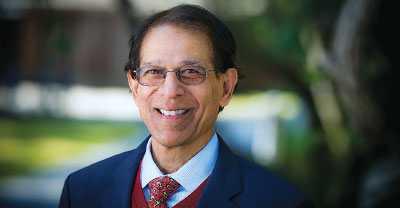One resident of an independent-living community in San Diego described the feeling of loneliness as “Ugly. Just Ugly.” To be lonely, another said, is like a “sudden loss of control over your life.”
These residents all lived in a community with a plethora of activities designed to bring them together. Yet, as a study published on January 10 in Aging and Mental Health found, even older adults living in an environment meant to encourage socialization experience strong feelings of loneliness.
“We wanted to do a study in older people who had no social isolation,” said past APA President Dilip Jeste, M.D., one of the study’s authors. Jeste explained that loneliness and social isolation are related, but they’re often confused with each other. “The difference is that loneliness is subjective,” he said. “One feels lonely, whereas social isolation is objective and refers to the number of social relationships one has.”
In the independent-living community, “we found loneliness was quite common,” said Jeste, the senior associate dean for healthy aging and senior care, distinguished professor of psychiatry and neurosciences, and director of the Sam and Rose Stein Institute for Research on Aging at the University of California, San Diego. Two of Jeste’s University of California, San Diego, colleagues were co-first authors of the study: Alejandra Morlett Parades, Ph.D., a research fellow, and Ellen E. Lee, M.D., an assistant professor in residence.
Between April 2018 and August 2019, Jeste and his colleagues assessed loneliness in more than 100 residents of the San Diego County independent-living community using version three of the UCLA Loneliness Scale, which is designed to measure subjective feelings of loneliness.
On the UCLA Loneliness Scale, the residents had a mean score of 39.3, which is considered moderate loneliness, with 15% reporting no/low loneliness, 63% reporting moderate loneliness, and 22% reporting high loneliness.
Researchers also conducted qualitative interviews with 30 residents between the ages of 67 and 92. The interviews included questions like “Do you ever feel lonely, and if so, how often and how would you describe the feeling?” and “What do you do, or think that others can do, to not feel lonely anymore?”
The authors separated the results of the interviews into three main themes: risk and protective factors for loneliness, experience of loneliness, and coping strategies to prevent loneliness.
“Many subjects described the subjective experience of loneliness such as feelings of sadness and hopelessness, while some non-lonely subjects perceived lonely people as lacking motivation,” the authors wrote. Other participants attributed their loneliness to aging-associated losses, such as the death of partners, family, and friends.
“They felt empty,” Jeste said. “They felt abandoned. They felt they didn’t have anybody who cares for them. One person said she feels incarcerated when she feels lonely.”
The study shows why solutions to loneliness such as increased engagement on social media or going into public spaces like libraries to encourage meeting new people does not work for everyone, Jeste said. “Even if people do those things, they may still feel lonely,” he said. “We must stop thinking that we can cure loneliness just by increasing people’s social relationships.”
The study also illustrated an “inverse relationship between loneliness and wisdom.” Jeste has studied the concept of wisdom closely, defining it as a personality trait comprised of emotional regulation, self-reflection, decisiveness, compassion, and spirituality. Some interviewees identified spirituality as protective against loneliness, for example, while other strategies to prevent or cope with loneliness included compassion, a key component of wisdom. (See
Psychiatric News.)
“Loneliness is a red flag,” said Robert Roca, M.D., M.B.A., M.P.H., an associate professor of psychiatry and behavioral sciences at Johns Hopkins University School of Medicine and chair of APA’s Council on Geriatric Psychiatry. “The study’s message for clinicians, and even for the research community, is that if you’re going to understand loneliness, you have to understand the person, their circumstances, and what loneliness means for them.”
Loneliness could be caused by a number of factors, continued Roca. It may be a result of acute bereavement, depression, or lifelong social anxiety, for example. “When you encounter loneliness as a clinician, you need to dig deeper to understand where it comes from,” he said.
Social isolation and loneliness are associated with adverse health outcomes. “We don’t want our patients to drink too much and we don’t want them to smoke because these have adverse health consequences,” he said. “But we’ve discovered that social isolation and loneliness are comparably potent risk factors, and they’re being appreciated as public health problems.”
Jeste argues that, just as society promotes physical activity and healthy nutrition in schools and workplaces, so too should it promote wisdom as a healthy behavior to prevent loneliness.
“Loneliness is becoming more common and can lead to depression and suicide,” Jeste said. “We need to do something at a societal level: How do we spread compassion? How do we make people feel more self-reflective? How do we make people [better] regulate their emotions? These are things we need to start thinking about.”
The study was supported, in part, by a NARSAD Young Investigator grant from the Brain and Behavior Research Foundation; the National Institute of Mental Health; the Stein Institute for Research on Aging at the University of California, San Diego; and the IBM Research AI through the AI Horizons Network. ■
“Qualitative Study of Loneliness in a Senior Housing Community: The Importance of Wisdom and Other Coping Strategies” is posted
here.
“A Pragmatic Trial of a Group Intervention in Senior Housing Communities to Increase Resilience” is posted
here.


